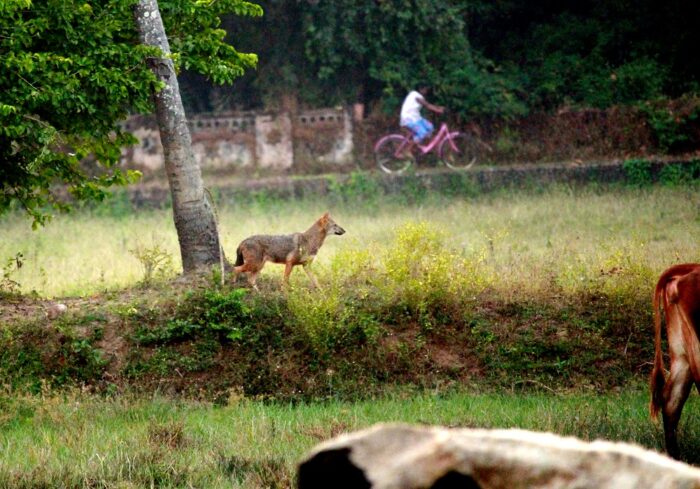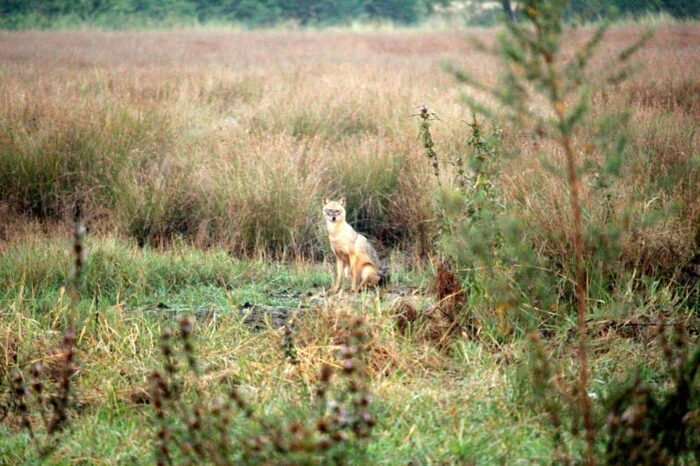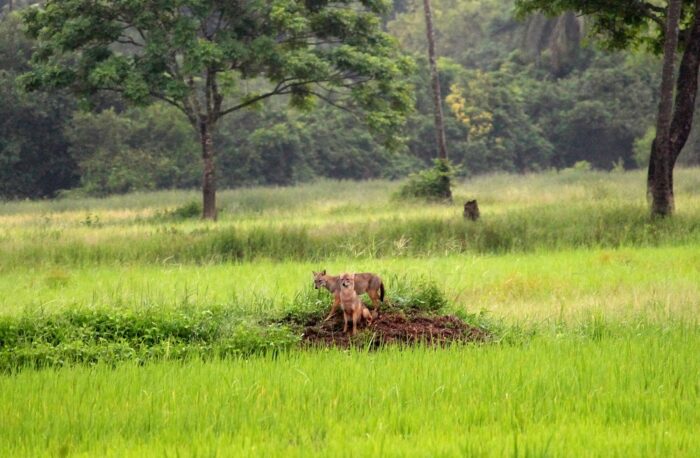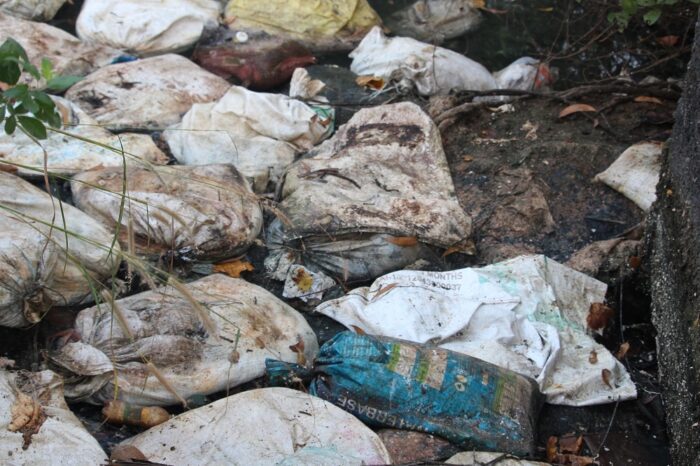
Two years ago I shifted to my new home in South Goa, to start life afresh. Amongst the many new things I became acclimatized to, is the piercing cry of the jackals that live in my village. The golden jackal or Asiatic jackal forms a part of the semi-urban landscape of many villages in Goa. They are group-living animals. They persist in human-modified habitats like crop fields as well as fragmented patches of scrubland, mangroves and hills. Jackals have also been sighted near garbage dumps in big cities like Margao, in graveyards and even on beaches. Even though jackals can adapt to changes in the land, these animals require natural sites free of human interference for denning purposes. One might come across a jackal crossing a road once a while, a pair of jackals camouflaged against the long stalks of dry grass or even a pack foraging on the garbage dumped in the fields. But jackals are mostly elusive- jackal pups and the dens are their well-kept secret. Jackals in Goa are often mistaken for foxes and sometimes wolves. In Konkani, ‘kolo’- the term meant for jackal- is wrongly translated into English as fox.
Most studies on the Golden Jackal in India have been restricted to protected areas. Although, a web-based survey conducted by Nature Conservation Foundation in the year 2011 attempted to seek answers about jackal distribution and population outside protected areas. Data obtained from participating citizens revealed its presence from Jammu and Kashmir in the north to Kerala and Tamil Nadu in the south and Gujarat and Rajasthan in the west to Tripura in the east. Despite there being data gaps, it can be noted that the presence of jackals is seen throughout India even though the study showed that populations seemed to be decreasing in the southern and eastern region and Uttarakhand. Only 2 observations were made from the state of Goa. Scientists have urged conservationists to monitor local populations of jackals in their area, to avoid a similar event like that of the disappearing vultures. In Europe, the Golden Jackal distribution has been dynamic, including dramatic declines, recovery and expansion. The jackal population in Greece has experienced a large-scale population decline in the last 25 years. The causes for decline were attributed to the limited habitat availability due to changes in human agro-pastoral activities, which resulted in reduced day-cover availability and a possibly reduced food base. The Golden Jackal is listed as ‘Least Concern’ on the IUCN Red List and is included in CITES Appendix III in India. Jackals are protected under Schedule II Part II of the Indian Wildlife Protection Act (1972).
The Koles of Saligão
Folklore and popular myths often portray jackals as being cunning and sly. The inhabitants of Saligão village are referred to as uxellantle kole (foxes in the sugarcane field) or ‘the koles of Saligão (foxes of Saligão)’. In his book “Land of the Sal Tree”, Father Nascimento Mascarenhas, explains how Saligaokars got stuck with this nickname. When the villagers began the plantation of sugarcane, the jackals would come down from the hills into the fields to feed on the ripened crop. The farmers were successful in keeping them away during the day, but then the jackals started foraging at night. The villagers formed groups of guards and each group had to guard the fields at different times. These guards took shelter in palm leaf tents known as khompteo that were set up in the fields and chased away any unsuspecting jackal with sticks and stones. Hence Saligaokars protected their sugarcane plantations by “outfoxing the foxes”.

Living with Jackals
But how much do we really know about our neighbours in the wild? As a part of my third year BSc project in Zoology, I decided to study public attitudes toward jackals in a semi-urban landscape, along with few of my classmates. Human-wildlife interactions are receiving increasing attention among researchers to understand their type and nature within urban, semi-urban and rural environments. This knowledge can help to manage, mitigate or even promote these interactions. We conducted interview surveys among 307 households to understand certain ecological aspects and conservation concerns of the jackal. Ecological knowledge, human-jackal interactions, personal experiences, folklore, childhood stories and hunting practices were documented. The first reaction to jackals was almost always an exaggerated “Tim sodanch kulio ghaltai (They are always howling).” Often, they would even imitate the calls in an animated manner, followed by embarrassed giggles. A few people would also talk about jackals stealing their piglets and chicken once a while. A migrant worker who works in a dairy farm in Deussua encounters jackals on a daily basis: “Abhi sham ke chaar baje kutton ke jaise idhar udhar ghoomenge aur phir raat ko bahut awaaz karenge”. (At 4 in the evening they will be roaming around like dogs and then they will make a lot of noise at night). It is especially interesting to listen to their cries as soon as the church bell rings at 6:30 in the evening or when crackers are burst during village festivities. A man whose house is next to a field, said that he throws his chicken waste for the jackals when they make “too much noise”.
Jackal Cough
The Konkani term for whooping cough is kolo khonkli, literally translating to ‘jackal cough’. The origin of this Konkani term is an interesting one. Kids and adults suffering from whooping cough give out a whooping sound after each cough. This sound has been compared to the cries of the jackals, hence the name jackal cough. In some villages, grandmothers and grandfathers previously believed that when a jackal cried, the howls heard by small children could cause them to suffer from kolo khonkli. As a preventive measure, elders would blow into the ears of these children as soon as the jackals begin to howl. But if the child does happen to suffer from kolo khonkli or ubush (asthma), a concoction called kolo soro was believed to cure the cough. People had differing views about the making of kolo soro. One man told us that when he was fifteen years old, in the late 1970s, he was employed by an old lady in the village to catch jackals and kill them for meat. He and his friends would take dogs along to search for jackal dens, close to the river. The dogs would sniff out the denning site and give away the location of the puppies. One blow on the head with a wooden stick was enough to knock them unconscious and even kill them. The jackals would then be tied and with a thick rope and slaughtered into pieces. One jackal puppy would fetch them ten rupees while an adult jackal was worth fifteen rupees. The old lady would ferment the meat for 8 days and then add hot cashew feni to it in a distillation unit. Toddy tappers in the village would normally make and sell kolo soro. Another man of the same village told us that people would eat jackal meat some sixty years ago. According to him, kolo soro was made up of jackal blood distilled with feni. Jackals would make their dens in the mangrove embankments or bandhs. The opening of the den would be filled with hay and chillies and then a fire would be lit. The smoke would suffocate the jackals and consequently the jackals tried to escape out of the den. In this process, they would be caught and a blow on their heads with a stick would finally kill them. The blood would be used in the making of kolo soro. Several other home-made remedies for kolo khonkli included honey, feni, sugarcane syrup (kakom), pineapple juice, and the blood of other wild animals like mongoose, monitor lizard, and rats.

A Good Omen
We also come across people talking about hyenas being present in the village at one point of time. They recall the calls of the jackals being different from that of the hyenas’. The call of the hyena was associated with misfortune and death. “Ganvant kitem vait zata, konui morta, tednam bali rodta. (The hyena would cry if there was a death in the village)”. In contrast, jackal howls were considered a good omen by some. There are also children stories revolving around jackals. In one story, the village kids would ask the jackal to throw down some jamun berries or jamblam from the tree. In another story a jackal was caught stealing sanna (sweet rice cake) from an old lady’s house. To teach him a lesson, she lights his tail on fire.

Safeguard of our Urban and Rural Wilds
During day time field observations in Deussua, we observed jackals foraging on garbage dumped at the side of the road and in the field. A rivulet of the Sal that passes through the village is a popular dumping ground for slaughter waste that is tied up into cement sacks and discarded. Carcasses of cattle are often dumped into the mangroves. These human-generated food sources are available to village dogs, jackals, birds of prey and other scavengers. A study conducted in Serbia in 2016 shows that the ecosystem services provided by the Golden Jackal in a human-dominated landscape are of great value to local communities in the modern world. The results were scaled up at the continent level indicating that in Europe, jackals annually remove 8842 tonnes of domestic animal remains, 4301 tonnes of wild ungulate remains and 158.2 million crop pest rodents. Jackals and other mesocarnivores are rarely appreciated for these services of waste removal and reducing the spread of disease. Mesocarnivores are particularly important in areas where there are no longer apex predators- leopards and tigers- or obligate scavengers like vultures. Jackals were common throughout the state of Goa but in the recent past, its population has undergone a significant decline.

Panchayats should play a crucial role by avoiding mindless concretization of bandhs, land filling, hill cutting, mangrove felling and other destructive modes which pass for developmental work. Lack of awareness and will among Town and Planning, policy making, municipal and panchayat bodies, in particular the Biodiversity Management Committees (BMCs) result in these bodies becoming mere tokenism. Further, immunization and sterilization programmes for community/stray animals are not undertaken by most panchayats resulting in their abuse as well as threat to some of the wildlife. Rapid road construction and accompanied apathy towards the non-human species are wreaking havoc resulting in what is gently termed as ‘road kills’. Construction of overpasses, underpasses and road signs can help reduce wildlife-vehicle collisions. Crucial habitats like rivers, mangroves, and scrubland shelter a diverse range of creatures like leopard, smooth coated otter, marsh crocodile, palm civet, monitor lizard, mongoose, and several other birds, reptiles, amphibians, fish and insects. These habitats also support local livelihoods like fishing, aquaculture and livestock rearing. We are closely intertwined with the land and our natural heritage. It’s high time we value and protect our urban and rural wilds.
Bibliography
- Borker, A. S. Small Mammals of Goa. Goa Forest Department.
- Cirovic, D., Penezic, A. and Krofel, M. (2016). Jackals as cleaners: Ecosystem services provided by a mesocarnivore in human-dominated landscapes. Biological Conservation
- Decker, D., Riley, S. and Siemer, W. (2012). Human dimensions of wildlife management. Baltimore: The John Hopkins University Press.
- Dickman, A. J. (2010). Complexities of conflict: the importance of considering social factors for effectively resolving human–wildlife conflict. Animal Conservation.
- Giannatos, G. (2004). Conservation Action Plan for the golden jackal Canis aureus L. in Greece. WWF Greece., 47.
- Jhala, Y. and Moehlman, P. (2008). Canis aureus. The IUCN Red List of Threatened Species .
- Mascarenhas, N. J. (2012). Land of the Sal Tree: Stories of the history, legends and traditions of Saligao a typical Goan village. Panjm: Goa 1556.
- Roemer, G., Gompper, M. E. and Valkenburgh, B. V. (2009). The Ecological Role of the Mammalian Mesocarnivore. BioScience, 59 (2): 165–173.
- Shetty, A., Pillay, R., Sankaran, P. and Madhusudan, M. (2011). Nature Conservation Foundation Jackal Survey Report. Nature Conservation Foundation.
- Soulsbury, C. D. and White, P. C. (2015). Human–wildlife interactions in urban areas: a review of conflicts, benefits and opportunities. Wildlife Research, 42(7): 541-553.
Acknowledgements
Project guides: Dr Manoj Borkar, Mr KN Mishra
Group members: Vaibhavi Naik, Jyotsna Dessai, Shubham Mapari and Avril Fernandes
Congrats
A heart-warming read.
Trust I shall see and read more of your work… Luck and Care
Dear Malaika, I feel proud to have mentored you for this work. Of course there’s a long way to go….. but well begun !
Try and convert this data into a research manuscript and publish it in peer reviewed journal to get peer recognition.
Best of Luck for your further pursuit of Wildlife Biology.
Interesting read. Gives insight into a completely new world for a usual city dweller.
Wow Malaika, so happy to read your blog!
Great going!
This is an excellent article covering environment and wild life co- existence